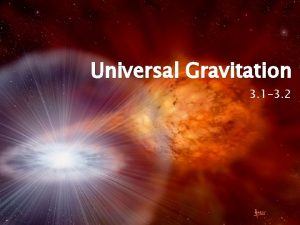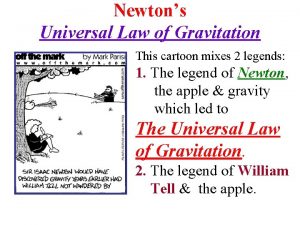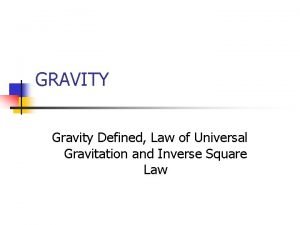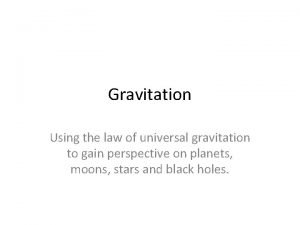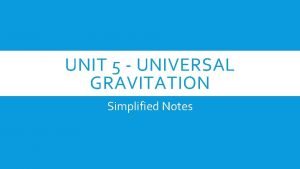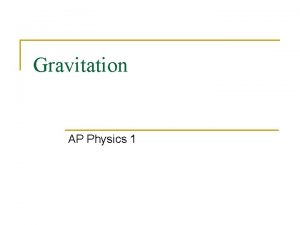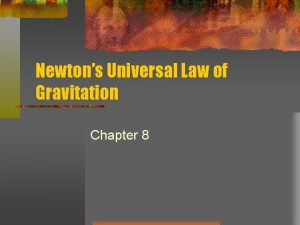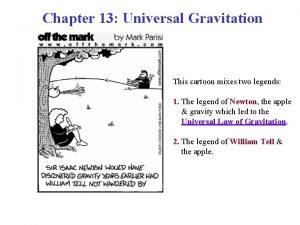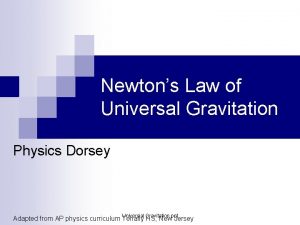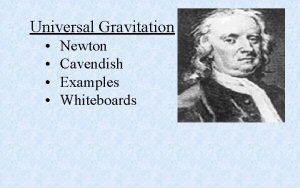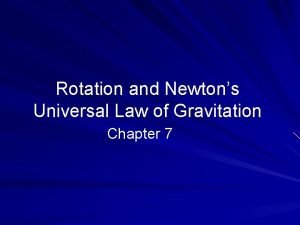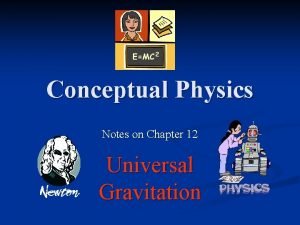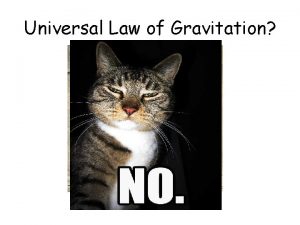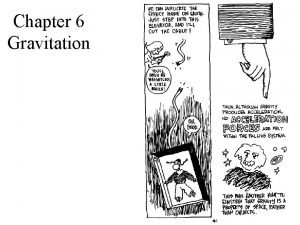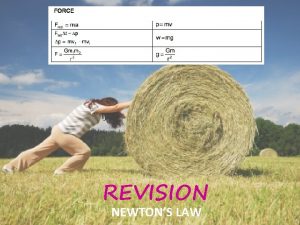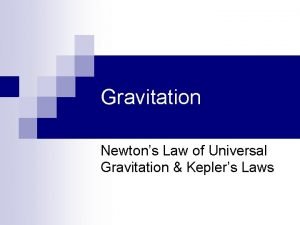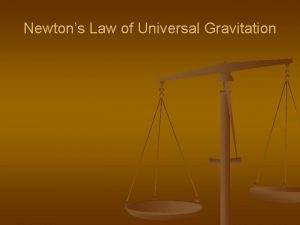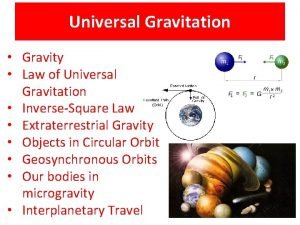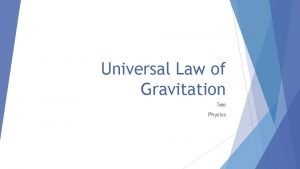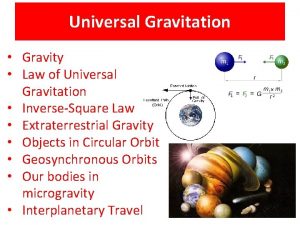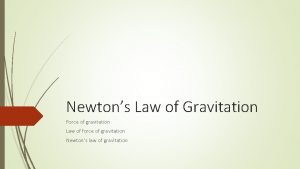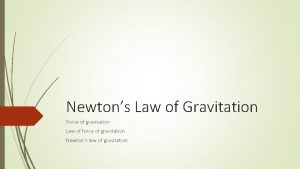Chapter 8 Newtons law of universal gravitation Presented













- Slides: 13

Chapter 8: Newton’s law of universal gravitation Presented by Joseph Farley

History of Gravity • Aristotle – Earth at center of universe; “force” moves things towards the states in which they belong • Copernicus – Different model of universe; something missing • Galileo – Relation between “gravity” and mass • Kepler – Laws of planetary motion; Sun drove “gravity” system • Newton – Derives law of universal gravity from Kepler’s

Johannes Kepler – 1570 to 1630 • German mathematician, astronomer, astrologer, and “natural philosopher” • Copernican – heliocentricism – Defended and strengthened model • Three Laws of Planetary Motion – Provided foundation for Newton’s arguments concerning universal gravitation

Kepler’s Laws of Planetary Motion 1. The orbit of a planet is an ellipse with the Sun at one of the two foci. 2. A line segment joining a planet and the Sun sweeps out equal areas during equal intervals of time. 3. **The square of the orbital period of a planet is proportional to the cube of the semi-major axis of its orbit. **

Kepler’s Laws of Planetary Motion 1. The orbit of a planet is an ellipse with the Sun at one of the two foci. 2. A line segment joining a planet and the Sun sweeps out equal areas during equal intervals of time. 3. **The square of the orbital period of a planet is proportional to the cube of the semi-major axis of its orbit. ** R 3 Constant 2 τ

Newton’s Principia – Law of Universal Gravity • First: Six deductions from astronomical data and observations to support Kepler’s Laws – Involves heavenly bodies orbiting one another • Next: Develops propositions about nature of forces necessary to produce these phenomena – Kepler’s laws require a central, inverse-square force

Inverse-Square Law 1 R 2 • Must be the case for Kepler’s laws to be true • Derived from Argument for Centripetal Acceleration – Centripetal – Inward force – Centrifugal – Outward force (opposite) • Leads to derivation of the law of attraction Fc 2 4π m 2 R Constant

Law of Gravitation for Point Masses • Generalized the previous equation for all masses, not just the Sun • Force seems to be propagated instantaneously https: //www. youtube. com/watch? v=p_o 4 a. Y 7 xk. Xg

Issue with Equation • Previous equation was for point masses, but planets are not point masses • Newton worried greatly about this and why it should hold for extended spheres. • Theorized about homogenous spherical shell – Inside shell – no net force experiences – Outside shell – experience force as if it were coming from center of sphere (center of mass) • Simple calculus exercises exist to prove this by summing individual parts

Something to Think About • Consider an object with two different physical properties: – One property relates to a resistance to change in the object’s motion – Another property relates to the objects capacity to exert and feel attraction from other objects • Are these properties the same? Could they be? What does that imply? • What could these two properties be? – Mass and electrical charge of a point charge?

Inertial Mass vs. Gravitational Mass • Newton considers these two properties to be different in his laws, but are they different? – He does not use these terminologies • No reason exists for these masses to be related in any way • Newton supports the idea that they are close to the same through experimentation with pendulums • Must be the same for other previously established laws to be true • Is there any proof or reasoning for this yet?

Thank You Einstein!! https: //www. youtube. com/watch? v=IM 630 Z 8 lho 8

Additional Videos • Football • https: //www. youtube. com/watch? v=m 5 CDVdglp 4 • Size of Solar System • https: //www. youtube. com/watch? v=z. R 3 Igc 3 R hfg
 Explain newton’s universal law of attraction/gravitation.
Explain newton’s universal law of attraction/gravitation. Newton's third law cartoon
Newton's third law cartoon تسارع الجاذبية
تسارع الجاذبية Universal gravitation law
Universal gravitation law Angular acceleration formula in terms of radius
Angular acceleration formula in terms of radius Universal gravitation law
Universal gravitation law Universal law of gravitation calculator
Universal law of gravitation calculator Newton's universal law of gravitation ap physics 1
Newton's universal law of gravitation ap physics 1 Newton's universal law of gravitation simplified
Newton's universal law of gravitation simplified Chapter 13 universal gravitation
Chapter 13 universal gravitation Law of universal gravitation ppt
Law of universal gravitation ppt Law of universal gravitation kid definition
Law of universal gravitation kid definition Newton's law of gravitation
Newton's law of gravitation Conceptual physics chapter 13 universal gravitation
Conceptual physics chapter 13 universal gravitation
